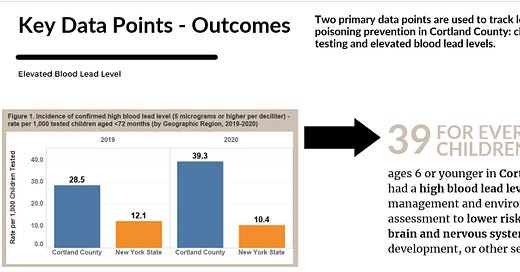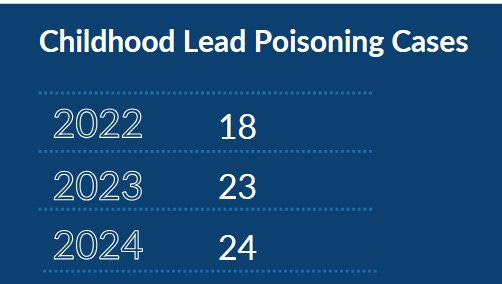Cortland has a Lead Problem -- and the County plans to give back a $1.9 million grant to address it
At this year’s Cortland Counts forum hosted by Seven Valleys Health Coalition, Margaret Broderick, MPH, Epidemiology Manager, and Suzanne Osterhoudt, RN, BSN, Supervising Public Health Nurse, from Cortland County Health Department presented on Lead Poisoning in Cortland County. Their presentation highlighted the high rates of lead poisoning in children ages 6 or younger in Cortland County. In 2020 in Cortland County, 39 out of every 1,000 children tested had elevated blood lead level — almost 4 times the rate of New York State. In 2020, Cortland County had the second highest incidence of confirmed high blood levels in Central New York.
The Cortland County Health Department’s annual report also shows that childhood lead poisoning cases are going up every year:
As the U.S. Centers for Disease Control and Prevention (CDC) documents, exposure to lead can seriously harm a child’s health and lists the adverse effects of lead poisoning, including: damage to the brain and nervous system, slowed growth and development, learning and behavior problems, and hearing and speech problems. Lead exposure can cause lower IQ, decreased ability to pay attention, and under performance in school. (On a related note? The Cortland School district has shown a $2.3 million increase in cost to educate students with special needs, one of the reasons for the increased 2025-2026 school district budget proposal. )
Most children are exposed to lead through lead paint in old homes. Cortland has outdated housing stock so chipping paint from the interior or exterior - combined with children’s hand-to-mouth behavior - is the number one cause of exposure.
While the Cortland County Health Department has managed the Childhood Lead Poisoning Prevention Program since the early 1990’s, the program involves “general education on lead poisoning, care coordination of children with elevated blood lead levels and environmental assessments of homes frequented by children with elevated blood levels,” it does not focus on lead abatement - painting or fixing the actual housing. Most of the homes with lead paint were built before 1930 (90.6%) and are rental units ( 59.4%).
As a resident interviewed for the Cortland County Health Department’s Photovoice Project so aptly encapsulates the problem:
“Maybe you went to the doctor and your kid had a high lead level, but even then - oh, you have high lead levels, oh your house has lead paint chipping - then what? Then what happens after that? You need to repaint, and like you said, that’s a lot of money, and that wouldn’t be anything near a budget for my household.”
So, it would have been welcomed news that the Cortland County Health Department was awarded a $1.9 million grant from the U.S. Department of Housing and Urban Development (HUD) to partner with CAPCO and the Rural Health Institute to “expand” the Health Department’s efforts. The grant would have funded assessment and remediation for 100 units for lead, radon, and other home health hazards.
The initial resolution was passed by the Cortland County Legislature on March 27, 2025 (meeting minutes, page 20):
WHEREAS, The U.S. Department of Housing and Urban Development (HUD) has awarded $1,933,255.30 to the Cortland County Health Department; AND
WHEREAS, these funds will be used to address multiple childhood diseases and injuries in the home by focusing on housing-related hazards in a coordinated fashion. The program will expand the Health Department’s efforts to address a variety of high-priority environmental health and safety hazards; AND
WHEREAS, the Cortland County Health Department will partner and contract with CAPCO and RHI to help facilitate the grant deliverables; NOW THEREFORE BE IT
Then, pretty quietly, it ended up on the May 13, 2025 Finance and Administration Committee agenda to “rescind” the acceptance of the HUD grant as the requirements were not “feasible.” The resolution passed the committee (pg 8) and moves to the full Legislature for adoption at their May 22 meeting.
WHEREAS, Resolution No. 64-25 authorized the acceptance of Funds HUD Healthy Homes Production Grant; AND
WHEREAS, the requirements of this grant are not feasible; AND
WHEREAS, the Health and Human Services Committee of the Cortland County Legislature recommends not moving forward with this grant award, upon recommendation of the Public Health Director; NOW THEREFORE BE IT
RESOLVED, that Resolution No. 64-25 be and hereby is rescinded.
This resolution to rescind the grant funds is so vaguely written and obscures the grant’s initial purpose. It would have silently slid under the radar if Minority Leader Beau Harbin did not bring up lead abatement specifically in the discussion. (See recorded discussion, starting at 1:03) Cortland residents deserve more information in the public as to why we’re turning down $1.9 million to address a well-documented problem in our County.
Have the personnel cuts at the federal level and in HUD under the Trump administration made working with them unfeasible? Have staffing loses at the County level made the Health Department unable to administer the grant?
Those are great questions. Unfortunately, concerned residents are not permitted to ask questions. While a resident may be permitted to make a public comment, you are not permitted to ask a question and the committee will not respond to a question (See related post on speaking - or not speaking your mind - at the County Legislature). You can always contact your legislator and demand more information. But, there is no guarantee they will respond.
The Committee asserts that the funding may be reapplied for in the future or that a non-profit agency may take over the grant. As a community, government at the City and County level pushes much of the hard work of serving residents in need to non-profit agencies and this may yet be just another example of that pattern. This rescinding of funds will prevent — or in the best case, delay — services to those exposed to lead on a daily basis in their home.





Thank you for this powerful and well-researched piece. It’s deeply troubling to see Cortland County turning down a $1.9 million opportunity to confront such an urgent, documented public health crisis. Your writing brings to light what should never have been allowed to happen quietly—and underscores exactly why transparency and public engagement are so vital to good governance.